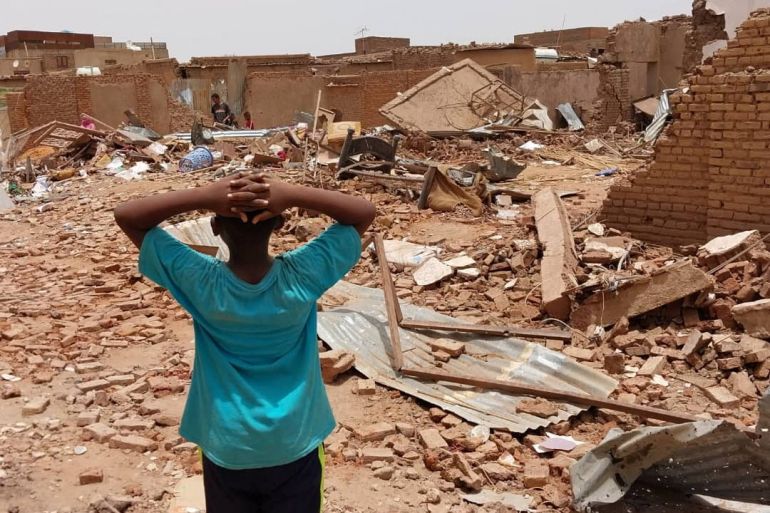Sudan fighting: One month on and no solution in sight
While the fighting did not come as a surprise to Sudan watchers, the world seems at a loss to stop the bloodshed.

One month ago, fighting broke out in Sudan. For some observers, it was not a surprise, given the tension that had built up over the preceding weeks as the country’s two biggest armed groups, the Sudanese Armed Forces (SAF) and the paramilitary Rapid Support Forces (RSF), wrangled for power.
The quiet on Saturday, April 15 was shattered by the sounds of artillery as residents of the capital Khartoum stood frozen in their living rooms, unsure whether the shooting would stop or even what they were actually hearing.
“Then the messages started: attacks, clashes, gunfire,” Dallia Abdelmoneim wrote for Al Jazeera in her account of fleeing Khartoum with her family, which subsequently split up among four or more destinations as they scattered from Port Sudan.
That same day, people reported fighter planes roaring overhead as the army began aerial attacks, ostensibly to rout RSF forces that had their camps in the midst of residential neighbourhoods. The death toll began to climb.
The world’s attention turned to Sudan as the fighting continued in Khartoum and other cities, including Merowe, a northern city on the way to the Wadi Halfa border crossing with Egypt that has big gold mines and a military airport, as well as an important reservoir on the Nile River.
In an odd twist to the story, news emerged that there were Egyptian troops stationed at the Merowe airport and that they had been captured by the RSF, which quickly said that it would be releasing them.
Ignoring international calls for a ceasefire, the two generals who head the SAF, General Abdel Fattah al-Burhan, and the RSF, General Mohamed Hamdan “Hemedti” Dagalo, allowed one short, three-hour pause on April 16 to allow people stuck in schools, offices, shops, and the Khartoum airport to return to their homes.
The international community began to make plans to evacuate its citizens and Sudanese people began trying to get out any way they could. Saudi Arabia and Jordan began evacuating their citizens and others by ship from Port Sudan, on the Red Sea in eastern Sudan.
Khartoum airport was closed, as it was the site of fierce fighting between the two sides, so families were paying exorbitant fees and enduring gruelling journeys to get to Port Sudan, Egypt, Ethiopia, and Chad. Port Sudan became a hub for people who needed refuge while they figured out their next steps.
Not everyone was so lucky, as a number of Sudanese people had applied for visas to travel to Western countries, and as the embassies evacuated and emptied out their premises, the passports were left behind, destroyed or moved to third countries for “safekeeping”.
Once the foreigners left, the Sudanese people who could not escape found themselves faced with deteriorating humanitarian conditions in addition to the danger of daily bombardments. Those living near the border with Chad started long journeys on foot to try to escape the violence.
From the beginning of the conflict, civilians in the cities had been helping each other, getting medicines and food to people who couldn’t leave home for one reason or another – and their work became even more essential as supplies ran short.
By April 20, the alarm was raised by the Central Committee of Sudanese Doctors (CCSD), which said 39 out of 59 hospitals in Khartoum and nearby provinces were no longer operational.
But stories of heroism prevailed, as doctors persisted in healing whoever came through their doors, delivering babies under fire and treating hundreds of wounded people.
Multiple ceasefires were announced and broken as the two generals remained locked into an existential battle for control of the country. Theories multiplied that both were struggling to control their forces, and analysts began to wonder if there could be a potential rival to Hemedti in his home state of Darfur.
Darfur, the site of fierce fighting in the past, remains a focal point as April nears its end, with fears rising that violence there could easily become a civil war.
As the conflict rolled on towards its fourth week and multiple ceasefires had come and gone, observers started wondering: Why do Sudan’s ceasefires keep failing?
One analysis was that the two sides were closer to different regional powers and as such did not feel safe laying down their arms even temporarily without the proper assurances.
By May 5, as the death toll surpassed 700, the two sides announced that they had accepted an invitation by Saudi Arabia and the United States to attend talks in the Saudi Red Sea city of Jeddah on May 6.
As mediators hurried between the two sides, seeking a pause to the violence to allow humanitarian aid to the indeterminate numbers of people in need in a country where one-third of the population already relied on aid, the fighting continued in Sudan.
By May 12, an announcement was made that the two sides had agreed to allow aid into afflicted areas and protect civilians. On the same day, the United Nations estimated that nearly one million people had fled Sudan, raising fears of the humanitarian crisis spiralling out of control.
With a second round of talks starting on May 14, what little optimism there was shattered as civilians in Sudan reported that there was little sign of the violence easing.